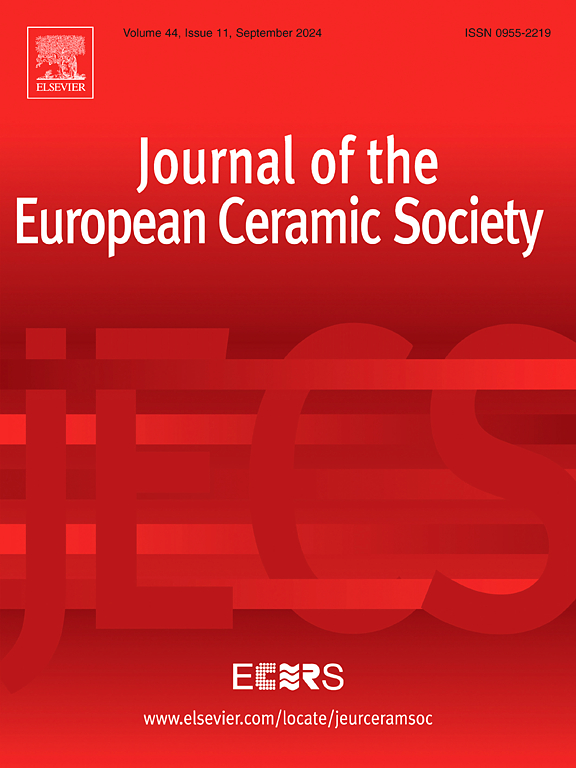Low oxygen transparency of Hf6Ta2O17 and homologous ZrxTa2O2x+5 series revealed by electrochemical impedance spectroscopy
IF 5.8
2区 材料科学
Q1 MATERIALS SCIENCE, CERAMICS
Journal of The European Ceramic Society
Pub Date : 2025-05-20
DOI:10.1016/j.jeurceramsoc.2025.117549
引用次数: 0
Abstract
Hf6Ta2O17 and Zr6Ta2O17 are promising thermal barrier coating (TBC) candidates due to their high melting points and low oxygen diffusivity. Electrochemical impedance spectroscopy was used to study dielectric and ionic properties of these materials, with higher measurement temperatures required and no clear distinction between the bulk and grain boundaries. Activation energies for oxygen diffusion were determined from Arrhenius plots of the measured conductivities: 1.76–1.89 eV for the ZrxTa2O2x+5 (x = 5, 6, 7, 8) homologous series and 2.26 eV for Hf6Ta2O17. Frequency mismatch between the peak imaginary impedance and peak imaginary modulus points to a local relaxation process as the dominant mode of charge transfer rather than a long-range (vacancy migration) mode. A table of activation energies for various TBC ceramics and these materials are presented. Hf6Ta2O17 and Zr6Ta2O17 are verified to be effective oxygen barriers protecting underlying substrates from oxidative corrosion at high temperatures.
电化学阻抗谱法揭示了Hf6Ta2O17和ZrxTa2O2x+5系的低氧透明度
Hf6Ta2O17和Zr6Ta2O17因其高熔点和低氧扩散率而成为热障涂层(TBC)的候选材料。采用电化学阻抗谱法研究这些材料的介电和离子性质,测量温度要求较高,且没有明显的体晶界区分。根据测量电导率的Arrhenius图确定了氧扩散的活化能:ZrxTa2O2x+5 (x = 5,6,7,8)同源系列为1.76 ~ 1.89 eV, Hf6Ta2O17为2.26 eV。峰值虚阻抗和峰值虚模量之间的频率不匹配表明局部弛豫过程是电荷转移的主要模式,而不是远程(空位迁移)模式。给出了各种TBC陶瓷和这些材料的活化能表。Hf6Ta2O17和Zr6Ta2O17被证实是有效的氧屏障,保护衬底在高温下免受氧化腐蚀。
本文章由计算机程序翻译,如有差异,请以英文原文为准。
求助全文
约1分钟内获得全文
求助全文
来源期刊

Journal of The European Ceramic Society
工程技术-材料科学:硅酸盐
CiteScore
10.70
自引率
12.30%
发文量
863
审稿时长
35 days
期刊介绍:
The Journal of the European Ceramic Society publishes the results of original research and reviews relating to ceramic materials. Papers of either an experimental or theoretical character will be welcomed on a fully international basis. The emphasis is on novel generic science concerning the relationships between processing, microstructure and properties of polycrystalline ceramics consolidated at high temperature. Papers may relate to any of the conventional categories of ceramic: structural, functional, traditional or composite. The central objective is to sustain a high standard of research quality by means of appropriate reviewing procedures.
 求助内容:
求助内容: 应助结果提醒方式:
应助结果提醒方式:


